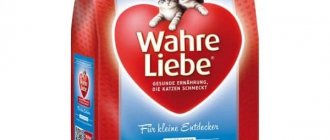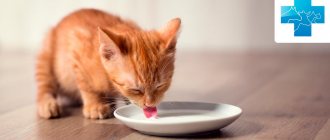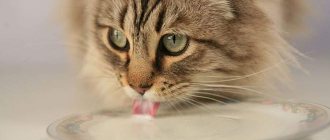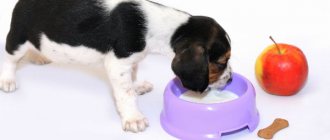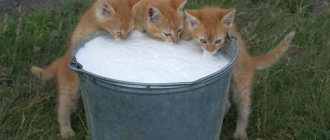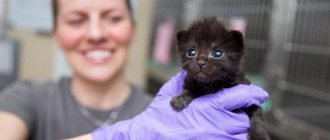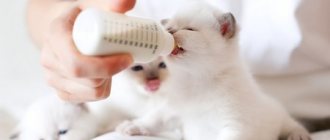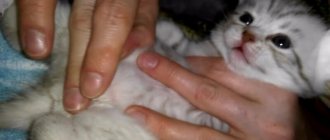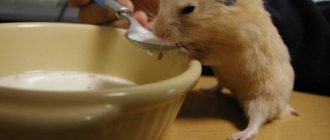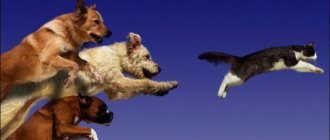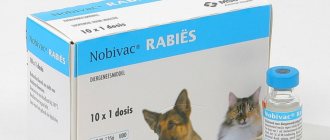Everyone is familiar with the picture of a flock of fluffy kittens huddled around a saucer, lapping up milk in unison, pushing each other away and getting into the saucer with their paws. Having eaten, they sleep sweetly, burying their noses wet with milk into each other. Isn't it cute? But whether it’s possible to give kittens cow’s or goat’s milk, not everyone knows about this.
Milk in the diet of kittens
At least until 2 months, the kitten's main food product is mother's milk. It contains all the elements necessary for intensive growth and development and provides immune protection for the baby’s body.
If for some reason the kitten is left without mother's milk, the only complete source of replacement can only be special dry formulas sold in specialized pet salons. For example, Beaphar Kitty-Milk or Royal Canin Babycat Milk.
In the absence of special mother's milk substitutes, you can give the kitten infant formula or goat's milk for a short time. Whole cow's milk is not a complete and correct substitute and can be harmful to the baby.
This drink was originally created by nature for feeding calves. Despite the fact that it contains many useful substances and amino acids, it also contains components that are not intended for the cat's body.
Cow's milk proteins are very poorly absorbed by kittens. In addition, store-bought milk is obtained from cows whose diet is based on industrial feed, so the content of pesticides and antibiotics in the drink will be very high.
Much higher than the permissible standards for the cat's body in cow's milk and casein with lactose. They are also difficult for small kittens to digest.
Goat's milk, although not such a complete replacement as mother's milk, is much closer to it in composition. It is only advisable to dilute it with boiled water to reduce fat content.
When purchasing a special cat's mother's milk substitute at a pet store, you should consider:
- Manufacturer's brand. It is advisable to choose only those that have good reviews from veterinarians and cat nutritionists.
- Breed of the kitten. For example, Maine Coons, Pixie Bobs, and some other varieties need more high-calorie nutrition.
- Fat content of the mixture. Ideally, it should not exceed 9%.
If the kitten is bottle-fed, after a month you can slowly introduce meat purees into its menu; by 2-3 months, milk should no longer be the main dish in the baby’s daily diet.
And by six months, this drink must be completely excluded from the kittens’ diet or replaced with another product, for example, kefir, since as cats grow older they lose the ability to absorb milk sugar.
How to properly feed a kitten
The best option for a baby who does not receive mother's milk is a special formula that balances all the necessary nutritional components. When feeding with formula, you should try to get closer to the conditions of natural feeding by the mother cat:
- you need to choose a warm and cozy place;
- the kitten should be placed on its stomach;
- should be fed through a kitten nipple;
- the pacifier should be held at an angle of 45 degrees;
- the kitten must stop eating when it is full;
- Feeding should be done every 2-3 hours until the baby reaches two weeks;
- after a month you can give solid foods.
A very small animal does not yet go to the toilet on its own, so a caring owner should help in this delicate matter. Mom always licks the kittens, so after eating you should press on the baby’s belly and wipe his butt with a cotton swab. If the pet does not get rid of waste products in time, the body may suffer from intoxication and even die. As the cat grows older, it learns to perform toilet functions on its own.
If the kitten needs to be fed, but there is no formula at hand, you need to adhere to the following principles:
- use baby formula, but dilute it to a thinner state than recommended on the package;
- preference should be given to goat's milk diluted with water rather than cow's milk
- You can add beaten egg white to your food;
- kefir is also suitable for a baby’s snack, but it should not be the main component of the diet;
- If the kitten doesn’t like the nipple, you need to use a pipette or syringe.
Upon reaching three months, the baby is ready for adult cat food.
Types of milk in a cat's diet
The most popular types of milk that owners can offer their pets are cow's and goat's.
Their comparative composition is given in the table.
| Index | Cow's milk | Goat milk |
| Fat content | 2,2 – 6,8 % | Average 4.5% |
| Vitamins | A; B1; B2; B6; B12; D; C. | A, D, E, C, B1, B2, B4, B5, B6, B12, H, PP, nicotinic acid. |
| Microelements | Calcium, potassium, phosphorus. | Calcium, potassium, phosphorus, magnesium, sodium, molybdenum. |
| Lactose content | High. | Minimal. |
| Calorie content, ml/100 g | 60 | 68 |
Despite the fact that goat milk has a high fat content, its composition is basically similar to cat and human breast milk, it contains more proteins, micro- and macroelements, and higher calorie content. At the same time, there is practically no alpha lipase, which causes the formation of fatty deposits.
Therefore, goat's milk is much preferable in pet nutrition than cow's milk:
- easier to digest;
- contains many lacto- and bifidobacteria, which improve digestion and gastrointestinal function;
- hypoallergenic, as it contains no proteins;
- minimal lactose content;
- lots of vitamins and minerals.
Goat or cow's milk is better to give
So, if, after all, the question of feeding a domestic cat with milk remains relevant, it is necessary to establish which product is better to choose? It is definitely better to purchase goat milk, which does not cause allergies or other adverse reactions. Before feeding, the fatty product must be diluted with clean boiled water.
Benefits of goat milk:
- fattier, but easier to digest composition;
- contains a large number of bifidobacteria and lactobacilli, which have a beneficial effect on digestion and the general condition of the intestinal microflora;
- hypoallergenic, protein-free;
- contains less lactose;
- a large number of vitamin and mineral complexes.
So, if you make a choice in favor of cow or goat milk for feeding domestic cats, it is better to go with the second option.
Is milk acceptable in the diet of an adult cat - benefit or harm?
Veterinarians and nutritionists advise excluding milk from a cat’s diet from 6 months, and some experts suggest doing this earlier - as early as 4 months.
This is due to the fact that this product contains a special element in huge concentration - milk sugar. Its breakdown is carried out in the cat's body under the influence of the enzyme lactose.
The body of any mammal produces quite a lot of it in infancy and childhood and produces practically none at all in adulthood.
The consequence of feeding an adult cat milk, especially cow's milk, is a malfunction of the gastrointestinal tract, the occurrence of dyspeptic symptoms - nausea, vomiting, diarrhea.
This theory is confirmed by almost all experts - product rejection occurs in most individuals, but there are exceptions to the rule.
Some adult and even elderly pets happily drink milk without any consequences for the proper functioning of the body. This is due to the individual characteristics of specific individuals. This means that it is in their body that a lot of lactose is still produced and the breakdown of milk sugars occurs successfully.
All adult animals like the taste of milk, but numerous studies have confirmed that it does not bring any benefit to the pet. Some cats, even in the absence of dyspeptic symptoms, may develop an allergic reaction when feeding them milk.
Thus, despite the assertion of some scientists about the indispensability of cow's milk in the diet of cats, most experts recognize this product as harmful and unacceptable in the diet of adult pets:
- The high calorie content of milk can lead to imbalance in the body and ultimately lead to obesity.
- The high content of casein and lactose does not allow the product to be completely absorbed.
- An extremely high concentration of elements that are unacceptable in the diet of an adult animal contributes to the development of allergies.
- Intolerance to milk sugars by the cat's body leads to indigestion, flatulence, bloating, indigestion, chronic diarrhea and dehydration.
Digestion of small and adult cats
As you know, a cat is primarily a mammalian predator. Until babies reach the age of three months, mother's milk is the only source of all the nutrients necessary for life. The intestines of recently born animals synthesize lactose, which helps process milk sugar. As in the case of humans, with age the cat’s body begins to produce less of this substance, while the animal’s appetite for milk may remain. In some adult cats, milk is a favorite food despite subsequent intestinal distress.
At about one month, kittens begin to eat adult food, including animal food. The baby's body gradually adapts from producing lactose to digesting meat and other products. For these components, protease is synthesized - another necessary enzyme that processes proteins.
After three months, animals usually refuse maternal feeding and begin to feed on their own. During this period of life, kittens are already ready for all the food that adults receive.
From this we can conclude that as a cat grows older, it loses the ability to process large amounts of milk, because it switches to producing meat, the main component of the diet of predators in the wild. After consuming milk, an adult animal may experience diarrhea, problems in the digestive system and pain. Sometimes an adult cat retains the ability to synthesize lactose, but in small quantities.
Although kittens can produce this enzyme, it is not suitable for every type of milk.
Compatibility of milk with dry food
Another question that concerns owners of animals that consume milk is its compatibility with dry formulas.
Ready-made industrial food is a completely balanced product containing all the necessary elements, and there is no need for your cat to drink it with milk.
With the simultaneous intake of milk and dry formulas, an excess of nutrients and microelements appears in the cat’s body, which settle in the form of deposits on the walls of the bladder and kidneys, leading to the development of urolithiasis. The liver also suffers, since this protective barrier of the body is filled with toxins. This product is especially dangerous for castrated cats and sterilized females.
Pets should drink food only with clean running water.
Cow's milk, even if replaced with goat's milk, which is less dangerous for cats, is an element of natural nutrition, and mixing it with feeding dry industrial food, according to veterinarians, is unacceptable.
Is plant milk suitable for a kitten?
Owners of kittens who support a vegetarian diet are wondering whether their kittens can be given plant-based milks.
Almond milk is made from a mixture of ground, unroasted almonds and water. There is no lactose in this milk. But almonds are toxic to cats.
Soy milk also does not contain lactose. But soy is very difficult for the delicate cat’s body to digest, since the kitten’s body does not have enzymes to process it. Even if your pet drinks soy milk, there will be no benefit from it.
Coconut milk is obtained by squeezing coconut pulp. Due to the high fat content of coconut milk, it is not only not healthy for the kitten, but in large quantities it is very harmful and leads to excess weight gain.
Cats are carnivores by nature, which makes it difficult for them to absorb plant-based substances. Therefore, you should not experiment with your pet’s nutrition. All a kitten needs is ordinary clean water. It is needed for the development of the cat’s body and promotes better absorption of food.
Kittens do not digest plant milk well
Replacing milk with fermented milk products
If the cat is a dairy lover and is on a natural diet, it is better to gradually replace this product with a fermented milk menu.
Kefir, fermented baked milk, natural yoghurts not only do not contain milk sugars, but are also enriched with lactic acid bacteria, which have a beneficial effect on digestion and the functioning of the entire gastrointestinal system of the cat as a whole.
There is no lactose in these products; it is what is converted into lactic acid during fermentation.
Using various types of fermented milk products, you can regulate and eliminate intestinal problems in your pet. So, for example, in case of regular constipation, fresh kefir will help, and in case of diarrhea, “old” (two-day old) kefir.
You can offer your cat milk without or with low lactose content, but usually such products do not delight your pet.
When choosing kefir, or better yet biokefir or fermented baked milk, you should pay attention to the fat content in them. It shouldn't be high. That is why you should not often offer your cat high-calorie cottage cheese or cheese, much less sour cream.
It is unacceptable to feed your pet sweet yoghurts and curds containing a lot of sucrose. Sugar is another harmful and dangerous human product for cats.
Lactose intolerance in kittens - signs
Lactose or milk sugar is found only in milk.
Symptoms of lactose intolerance become apparent approximately 8-12 hours after the kitten drinks the milk. Intolerance manifests itself in the form of diarrhea, vomiting and bloating.
This happens due to the inability of the kitten’s body to process lactose, which passes through the intestines unchanged. By attracting water, it moves further and in the large intestine it meets bacteria that try to process it. This is accompanied by the release of hydrogen, carbon dioxide and a number of other substances, causing fermentation in the kitten’s body.
Lactose is found only in milk
Reviews from veterinarians
Thus, the opinion of most veterinarians boils down to the following:
- It is not forbidden to feed your pets milk if it is normally absorbed by his body. But you should not give them this product in melted form (high fat content), cream and condensed milk.
- It is recommended to cook porridge in water, even semolina.
- The rest of the cats can be given low-fat and unsweetened fermented milk products, again, provided that they accept it normally.
But these products are under no circumstances mixed with ready-made industrial feed.
With a natural diet, the amount of dairy or fermented milk products per day should not exceed 20-30% of the daily diet, because a cat is primarily a predator. And her diet should be dominated by animal proteins, specifically meat. This is the best treat for any pet.
1111
Are sheep and goats allowed?
Goat's milk is easier to digest and is absorbed very quickly by the kitten's body. It should also be noted that it contains vitamins A, B1 and B2. The proteins contained in such milk are much less likely to cause intolerance in kittens. Goat's milk is better in composition than cow's milk. In addition, it is low-allergenic. Sheep milk is very similar in properties to goat milk.
Don't forget that store-bought cow's milk usually has reduced fat content, while goat's or sheep's milk is most often sold with natural fat content.
Thus, the question of whether it is possible to give a kitten goat’s milk can be answered positively, but it is advisable to dilute it with a small amount of water.
Goat's milk is much healthier for a kitten than cow's milk
What fermented milk products are allowed?
Preferential refusal of milk does not mean excluding everything related to it from the Murzik diet. Fermented milk products rarely cause bloating, are well digested and are much more beneficial for cats than cow/goat milk. To make it easier for you to choose food for your pet, we have compiled a shortlist of fermented milk. Products are listed in order of preference, from largest to smallest.
| Product | Fat content | Peculiarities |
| Kefir | Not higher than 2% | Fresh kefir weakens, standing for a couple of days strengthens |
| Cottage cheese | 5% or less | Cats should not be given a product that is two days old. |
| Cheese | low-fat (cheese cheese, feta, etc.) | Cheese should not contain salt or additives |
| Yogurt | maximum 3% | No impurities, salt, sugar |
| Ryazhenka/yogurt | until 3% | Infrequent inclusion in the diet is allowed, without fanaticism |
| Sour cream | excessively fatty, heavy product | Give infrequently, diluting with water, ratio 1:1 |
| Cream | too fatty food | It is strictly prohibited to include cream in a cat's diet. |
Gastronomic habits are formed from childhood. If you want to feed your animal fermented milk products, accustom him to it as early as possible. When introducing new food into the diet, be vigilant: give food in small portions, carefully monitor the four-legged well-being and continue complementary feeding only if the reaction to food is normal.
What is milk and what types does it come from?
Under the influence of the hormone oxytocyte, milk is produced in the mammary glands of female mammals. A valuable and very healthy product is introduced into the diet of newborn babies from the first days of life.
Milk contains a complex of immunoglobulins, many micronutrients, vitamins, proteins, fats and other beneficial substances that promote the rapid growth and proper development of the baby.
The most popular milk is cow's and goat's. Each product has certain beneficial properties. First, let's compare these two drinks and understand the difference.
Despite the high fat content of goat's milk, its composition is close to women's breast milk, so this product is more recommended for feeding babies.
The drink contains a large amount of easily digestible proteins and virtually no alpha lipases, which contribute to the accumulation of fat deposits. The product is dietary and most useful for feeding infants.
Now let’s try to figure out whether cats can be given goat’s and cow’s milk, and which product is better to choose for feeding?
What dairy products can cats have?
However, some products made from milk - fermented baked milk, kefir, yogurt - will benefit your cat. These products are obtained through fermentation, during which lactose is destroyed. But still, you shouldn’t rely on fermented milk products: the content of protein and other useful substances in them is low. Three times a week, in small amounts - as a supplement to the main portion, will be enough.
Such seemingly tasty and healthy products as cream, sour cream and condensed milk should absolutely not be offered to a cat - due to the high fat content (and condensed milk is also due to the high sugar content). Of course, introducing butter into your pet’s diet is unacceptable - these are fats in their pure form. One of the important rules for feeding cats is a low percentage of fat, since their digestion is not designed for fatty foods.
Milk replacer
Can cats drink store-bought milk? Many people choose store-bought pasteurized formulations as a substitute for cow's milk, but these products are also unacceptable for feeding animals.
An absolutely useless drink that loses all useful microelements during preparation and processing. Disadvantages also include calcium, which after pasteurization is not processed, but is deposited in the body and is practically not excreted, which contributes to the development of very unfavorable diseases.
Feeding regimen and norms
In order not to provoke disruptions in the gastrointestinal tract, it is equally important to monitor the feeding regime. Two-month-old kittens should be given food in small portions at the same time. Kittens at two months old should receive food 5-7 times a day. As the animal grows older, the number of daily feedings is gradually reduced and from the age of four months the animal can be switched to three or four feedings a day.
Up to 3-4 months, it is necessary to develop a diet and a stable meal schedule, observing it in the future. Kittens at two months old should receive food 5-8 times a day.
The daily norm for 2-month-old kittens, depending on the breed, is 120-135 g. When preparing a natural diet, take into account the level of activity, breed, individual characteristics of the kitten, and its state of health.
All the arguments for and against
It is impossible to say unequivocally whether milk will be beneficial for a particular cat. It all depends on the individual characteristics of the body, as well as on the usual diet. Milk does not go well with some foods; consuming them at the same time will inevitably lead to indigestion, even in absolutely healthy pets. You should not give milk and fermented milk products when feeding special cat food.
You need to give the animal natural products - country products, not purchased on store shelves or supermarkets. Their composition is far from natural products, the beneficial properties are reduced or completely absent. If the animal’s body does not tolerate cow’s milk, you can try goat’s or sheep’s milk. If there are unpleasant manifestations in this case, the product should be discarded. The situation is similar with sour milk. The main argument is why you can’t give milk to a cat, lactose intolerance, fat intolerance. If the body easily copes with the components, there are no prohibitions.
